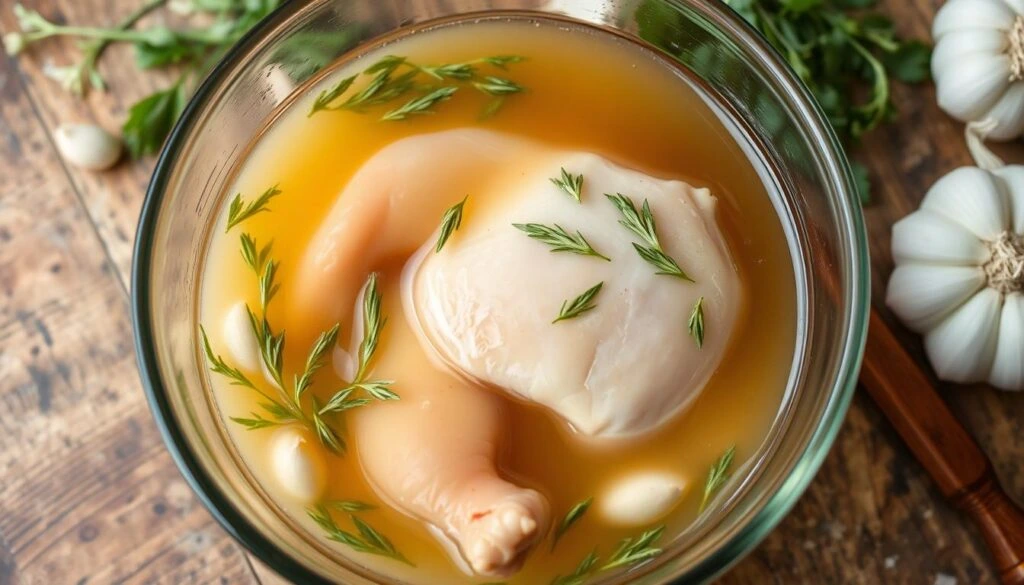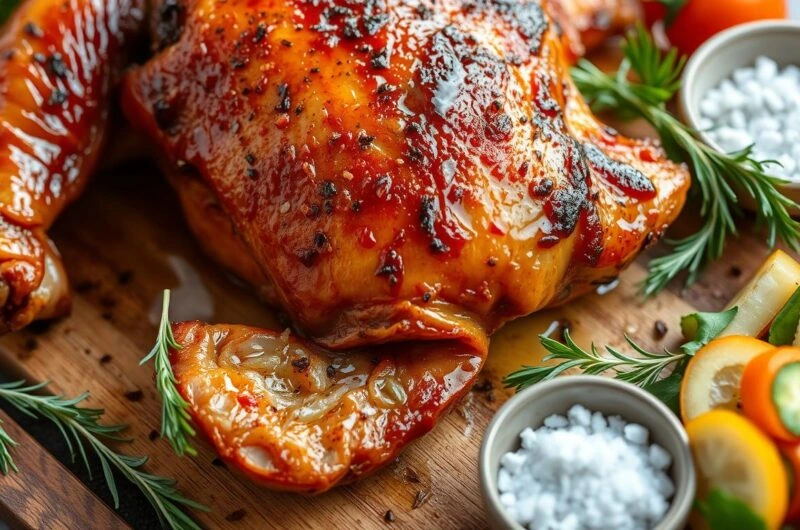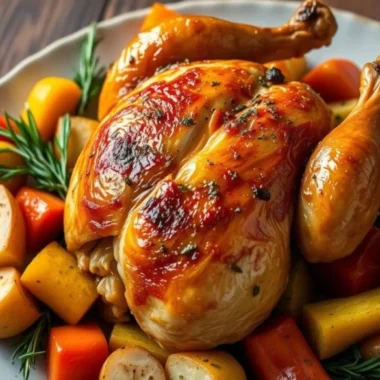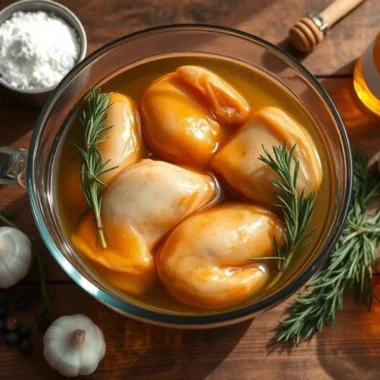I’ve always been fascinated by brining. It can make a simple chicken breast into a juicy, flavorful dish. My grandmother’s brined turkey at Thanksgiving was always the highlight – moist, tender, and full of flavor.
If you’re new to brining or have had mixed results, this guide is for you. We’ll explore the science, the best ingredients, and the step-by-step process. Brining will become your secret to amazing poultry dishes, whether grilled, roasted, or fried.
Table of Contents
What is Brining and Why It’s Important?
Brining is a simple yet effective technique that can transform your chicken. It involves soaking the meat in a salt-water solution. This unlocks a world of culinary benefits that will elevate your cooking.
But what’s the science behind brining? And why is it so crucial for achieving the best results with your chicken dishes?
The Science Behind Brining
The process of brining changes the meat in three key ways. It adds moisture, changes the texture, and seasons the meat from the inside out. The salt in the brine solution penetrates the chicken, causing the muscle fibers to swell.
This results in a juicier, more tender texture that is evenly seasoned throughout.
Benefits of Brining Chicken
- Juicier and more flavorful meat
- Improved tenderness and texture
- Better moisture retention during cooking
- Enhanced ability to withstand overcooking
Common Mistakes to Avoid
- Over-brining the chicken, leading to an overly salty flavor
- Using the wrong type of salt, which can result in an unbalanced brine
- Failing to adjust cooking times and temperatures for brined chicken
By understanding the science behind brining and avoiding these common pitfalls, you can unlock the full potential of your chicken dishes. A simple salt water brine for chicken can make all the difference. It creates juicy, tender, and flavorful meals that will impress your family and friends.
Choosing the Right Brine Ingredients
Creating a flavorful brine for chicken involves using salt, herbs, spices, and sugar. These ingredients boost the meat’s natural taste. They make the chicken juicy and well-seasoned.
Essential Salts for Brining
The salt you pick for your brine affects the flavor. Use Diamond Crystal kosher salt, Morton’s kosher salt, or fine/table salt. Aim for 1 tablespoon of salt per cup of water. You can adjust this based on your taste and the chicken type.
Flavor Enhancers: Herbs and Spices
Adding herbs and spices elevates your brine. Garlic, rosemary, thyme, peppercorns, and bay leaves are great choices. They add delicious aromas and flavors. Try different mixes to find what you like best.
The Role of Sugar in Brine
Sugar is optional but helps balance the brine’s saltiness. It also aids in browning during cooking. Use 1-2 tablespoons of sugar per cup of brine. Adjust to your liking.
Choosing the right brine ingredients makes your chicken juicy and delicious. It’s all about the flavors you add.
| Ingredient | Purpose | Recommended Amount |
|---|---|---|
| Salt (kosher or table) | Seasons the chicken, helps it retain moisture | 1 tablespoon per cup of water |
| Herbs and spices (garlic, rosemary, thyme, peppercorns, bay leaves) | Adds flavor and aroma | Adjust to your preference |
| Sugar (granulated, brown, or molasses) | Balances the saltiness and promotes browning | 1-2 tablespoons per cup of brine |
Preparing the Brine Solution
Making the perfect brine is key to juicy, flavorful chicken. It’s a mix of cold water, salt, and special ingredients. These add delicious taste to the chicken.
Basic Brine Recipe
Begin with 8 cups of cold water and 12 tablespoons of Diamond Crystal kosher salt. Stir until the salt is fully dissolved. You don’t need to boil the water. This mix is perfect for brining chicken.
How to Adjust for Flavor Preferences
- Add herbs, spices, or citrus zest to the brine for extra flavor.
- Try lemon or orange slices, crushed garlic, bay leaves, peppercorns, and fresh thyme or rosemary.
- Use honey or brown sugar to balance the saltiness.
Tips for Dissolving Salt and Sugar
- Use cold or room temperature water for the brine.
- Stir well until all salt and sugar dissolve.
- To speed up dissolving, heat a bit of water, mix in salt and sugar, then add it to the cold water.
Now that your brine is ready, you can soak your chicken. The secret is finding the right seasoning for your taste.
| Ingredient | Quantity |
|---|---|
| Cold Water | 8 cups |
| Diamond Crystal Kosher Salt | 12 tablespoons |
| Optional Flavor Enhancers | Lemon, orange, garlic, bay leaves, peppercorns, thyme, rosemary, honey, brown sugar |

Selecting the Type of Chicken for Brining
Choosing the right chicken for brining is crucial. Whether you pick a whole chicken or parts, fresh or frozen, there are important things to consider.
Whole Chicken vs. Chicken Parts
Brining works great for whole chickens and parts like breasts, thighs, or drumsticks. But, the brining time changes based on the chicken’s size and thickness. Larger pieces, like a whole chicken, need more time to soak up the brine well.
Fresh vs. Frozen Chicken
Fresh chicken is best for brining, but frozen chicken works too. Just thaw it first. Frozen chicken might need a bit longer in the brine because of its extra moisture.
Considerations for Organic Chicken
Organic chicken has more moisture naturally. This can change how you brine it. You might need to adjust the brining time for organic chicken to get it just right.
The main thing is to watch the chicken’s size, cut, and where it comes from. Adjust the brining time based on these factors. By choosing the right chicken and following the right brining steps, you can make your chicken incredibly tender and flavorful.
Brining Times: How Long to Brine Chicken
Brining is key to juicy and flavorful chicken. The brining time greatly affects the result. Knowing the right brining times for different chicken cuts is essential for success.
Whole Chicken Brining Duration
A whole chicken should brine for 4 to 6 hours. This ensures the meat is well-seasoned and moist. Brining less than 4 hours may not be enough, while more than 6 hours can make the chicken too salty.
Brining Chicken Parts
Chicken parts like breasts, thighs, or drumsticks need less brining time. Boneless, skinless breasts can brine for 30 to 60 minutes. Bone-in parts like thighs and drumsticks should brine for 1 to 2 hours. This prevents the chicken from becoming too salty.
Safety Guidelines for Brining Time
Always refrigerate chicken during brining if the time is over 30 minutes. This stops harmful bacteria from growing and keeps food safe. Also, avoid over-brining to prevent an overly salty chicken.
The best brining time can vary. It depends on the brine’s strength and the chicken’s size. Try different times to find the perfect flavor and tenderness for your dishes.
Steps to Properly Brine Chicken
Brining chicken is a simple yet effective way to infuse it with flavor and enhance its texture. To ensure your chicken brining process is a success, follow these essential steps.
How to Submerge Chicken in Brine
The key to proper brining is fully submerging the chicken in the brine solution. Use a large, non-reactive container, such as a large bowl or resealable bag, to hold the chicken and brine. Ensure the chicken is completely covered by the brine, weighing it down if necessary.
Cooling and Storing the Brine
Maintaining the proper temperature of the brine is crucial. Keep the container with the chicken and brine in the refrigerator throughout the brining process. This will prevent the growth of harmful bacteria and ensure the chicken remains safe to consume.
Monitoring the Brining Process
Carefully monitor the brining time to avoid over-salting the chicken. The ideal brining duration typically ranges from 4 to 6 hours, depending on the size of the chicken. For longer brines, check the chicken periodically and remove it from the brine once it has reached the desired level of seasoning and tenderness.
By following these steps, you’ll ensure your chicken brining journey is a success, leading to flavorful, juicy, and perfectly seasoned poultry every time.

Rinsing and Drying the Chicken Post-Brining
After brining, it’s key to get the chicken ready for cooking. Rinsing the chicken is not needed and can spread harmful bacteria. Instead, dry it well with paper towels on all sides.
Why Rinsing Matters
Rinsing can weaken the brine’s flavor, making the dish less tasty. It also risks spreading bacteria. To keep flavor and safety, skip rinsing and dry the chicken well.
Techniques for Drying Chicken
- Use paper towels to gently pat the chicken dry, ensuring all surfaces are thoroughly dried.
- Allow the chicken to air dry in the refrigerator for 30 minutes to an hour. This helps to create a crispier skin when cooking.
- Before cooking, let the chicken come to room temperature for even heat distribution and cooking.
Preparing Chicken for Cooking
With the chicken dry, it’s ready for cooking. Choose grilling, roasting, or baking. The dry skin will be crispy, and the inside will stay juicy. Follow these steps for a perfect brining chicken recipe.
Cooking Methods After Brining
Brined chicken can be cooked in many ways, each giving unique results. You might like the crispy skin of grilled chicken or the tender, juicy meat of roasted poultry. The right brining method can make your meal even better.
Grilling vs. Roasting
Grilling brined chicken makes the skin crispy and the inside juicy. The brine keeps the meat moist. Roasting also works well, keeping the meat tender and flavorful.
Baking Brined Chicken
Baking brined chicken cooks faster than unbrined chicken. The brine’s moisture helps it cook quicker. Just watch the temperature to avoid overcooking.
Slow Cooking Tips
Slow cooking is great for brined chicken, but watch the liquid. The brine’s salt can get too strong. Use low-sodium broth to keep flavors balanced.
| Cooking Method | Pros | Cons |
|---|---|---|
| Grilling |
|
|
| Roasting |
|
|
| Baking |
|
|
| Slow Cooking |
|
|
The best brining method for you depends on what you like. Try different cooking methods to find the perfect match for your brined chicken.
Recipes Featuring Brined Chicken
Brining chicken makes your favorite dishes even better. It adds flavor and keeps the meat juicy. Whether you grill, roast, or use leftovers, the results are amazing. Let’s look at some tasty ways to enjoy brined chicken.
Flavorful Grilled Chicken Recipes
For a zesty grilled chicken, marinate the brined chicken in olive oil, lemon juice, garlic, and herbs. Thyme, rosemary, or oregano work well. The brine keeps the chicken moist, while the herbs add a tasty crust.
Or, try a smoky barbecue-style brined chicken. Baste it with a sweet and tangy sauce during grilling.
Oven-Roasted Brined Chicken Ideas
Brined chicken is great for roasting too. A lemon-herb roasted chicken is a classic. Season the brined bird with citrus, garlic, and herbs.
Another choice is a garlic-rosemary roasted chicken. The brine enhances the herbs and garlic’s flavors. For a rustic dish, roast the chicken with vegetables. The juices from the chicken infuse the whole dish.
Creative Uses for Leftover Brined Chicken
Don’t waste leftover brined chicken! Shred or dice it and add to salads, sandwiches, or pizza. It brings flavor to your dishes.
Remember, the brine has already seasoned the meat. So, adjust the salt in your recipes. Enjoy the delicious results of your brining efforts!
| Recipe | Brining Time | Brine Ingredients | Cooking Method | Serving Size |
|---|---|---|---|---|
| Grilled Herb-Crusted Chicken | 12 hours | Kosher salt, brown sugar, thyme, rosemary | Grilled | 4 |
| Barbecue Brined Chicken | 8 hours | Kosher salt, brown sugar, paprika, chili powder | Grilled | 4 |
| Lemon-Herb Roasted Chicken | 24 hours | Kosher salt, brown sugar, lemon, garlic, thyme | Roasted | 6 |
| Garlic-Rosemary Roasted Chicken | 12 hours | Kosher salt, brown sugar, garlic, rosemary | Roasted | 4 |
These statistics show what’s popular in brined chicken recipes. Long brining times, herbs, and citrus are common. Kosher salt is often used. These insights can help create new recipes and inspire variations.
“Brining chicken is a game-changer in the kitchen. It consistently delivers juicy, flavorful results that elevate any dish.”
Storing Leftover Brined Chicken
After brining and cooking your chicken, you might have leftovers. Storing them right is crucial to keep the chicken juicy and flavorful. We’ll look at the best ways to store your brined chicken in the fridge and freezer.
Refrigeration Methods
Cooked brined chicken can stay in the fridge for 3-4 days in airtight containers. This keeps the meat moist and prevents it from drying out. Make sure the chicken cools down completely before refrigerating. Also, don’t let it sit at room temperature for over 2 hours.
Freezing Brined Chicken
To store it longer, freeze your brined chicken. Cooked chicken can be frozen for up to 4 months in freezer-safe bags or containers. Raw brined chicken can be frozen for 2 months. Thaw it in the fridge before cooking.
How Long Does Brined Chicken Last?
The shelf life of brined chicken varies by whether it’s raw or cooked. Raw chicken lasts 1-2 days in the fridge, while cooked chicken lasts 3-4 days. Frozen raw chicken can last 2 months, and cooked chicken can last 4 months. Always check for spoilage before eating.
By following these storage tips, you can enjoy your homemade brined chicken for a long time. Proper storage in the fridge and freezer ensures your chicken stays juicy and tender for weeks.
Troubleshooting Common Brining Issues
Brining can make chicken juicy and flavorful, but sometimes problems arise. If your chicken is too salty or not salty enough, we have solutions. These tips will help you fix common brining issues.
Overly Salty Chicken Solutions
Too salty chicken? No worries. You can fix it by soaking the chicken in plain water for 1-2 hours. This will remove excess salt. After soaking, rinse the chicken well and pat it dry before cooking.
Under-seasoned Chicken Fixes
Maybe your chicken tastes bland? You can boost the flavor by adding salt-free seasonings like herbs or spices. Also, try serving it with a tasty sauce or marinade. This will add to the chicken’s natural juices and taste.
Uneven Brining: Causes and Remedies
Sometimes, brining can make chicken unevenly seasoned. This might happen if the chicken wasn’t fully in the brine. To avoid this, make sure the chicken is fully covered. Also, flip the pieces a few times during brining. This ensures the salt and flavors are evenly spread.
FAQ
What is brining and why is it important?
Brining is a method where you soak chicken in salt water. It makes the chicken taste better, feel softer, and stay moist. This simple step can greatly improve your chicken dishes.
What are the benefits of brining chicken?
Brining chicken makes it juicier, more tender, and flavorful. It helps keep the meat moist and tender while cooking.
What are some common mistakes to avoid when brining chicken?
Don’t over-brine, use the right salt, and adjust cooking times. Following the right brining times and ingredients is key to avoid problems.
What are the essential ingredients for a basic chicken brine?
You need water and salt for a basic brine. Use kosher salt like Diamond Crystal or Morton’s. You can also add garlic, herbs, and spices for extra flavor.
How do I prepare the brine solution?
Mix 12 tablespoons of kosher salt in 8 cups of cold water. Add herbs and spices after the salt dissolves.
What types of chicken can be brined?
You can brine whole chickens or parts. Fresh chicken is best, but frozen chicken works too after thawing. Organic chickens might need less brining time.
How long should I brine chicken?
Brining times vary: whole chicken (4-6 hours), breasts (30-60 minutes), and parts (1-2 hours). Avoid over-brining to prevent too much salt.
How do I properly submerge the chicken in the brine?
Use a large container or resealable bag to fully submerge the chicken. Keep the brine cold and watch the time to avoid too much salt.
Do I need to rinse the chicken after brining?
No, rinsing is not needed and can spread bacteria. Dry the chicken with paper towels and let it air dry in the fridge for crispy skin.
What are some good cooking methods for brined chicken?
You can grill, roast, or bake brined chicken. Grilling gives a crispy outside, while roasting cooks evenly. Brined chicken cooks faster, so adjust times.
How can I use leftover brined chicken?
Use leftover brined chicken in salads, sandwiches, or as pizza toppings. Don’t add extra salt to dishes with brined chicken.
How should I store leftover brined chicken?
Store cooked brined chicken in airtight containers in the fridge for 3-4 days. Freeze for up to 4 months. Raw brined chicken can be frozen for 2 months.
How can I fix issues with overly salty or under-seasoned brined chicken?
For salty chicken, soak it in plain water for 1-2 hours before cooking. For under-seasoned chicken, add salt-free seasonings or a flavorful sauce. Uneven brining can happen if the chicken isn’t fully covered; make sure it’s fully submerged and flip it occasionally.
Source Links
- How To Brine Chicken Breasts – https://cookthestory.com/how-long-to-brine-chicken-breast/
- How to Brine a Whole Chicken – https://cookthestory.com/brine-whole-chicken/
- Brined and Fried Chicken – https://12tomatoes.com/brined-and-fried-chicken/
- The Science of Brining – https://howlowcanyouslow.com/the-science-of-brining/
- How to Brine Chicken: Our Guide to the Best Chicken Injection & Brine – https://www.heathrilesbbq.com/blogs/favorite-recipes/how-to-brine-chicken-our-guide-to-the-best-chicken-injection-brine
- How to Brine Practically Any Meat – https://www.tasteofhome.com/article/this-is-everything-you-need-to-know-about-brine/?srsltid=AfmBOooo9UWBE_zCEVv6uUq3VsmSpQZfO7JdN_O0UdPTYrTLqEfB3gmH
- Chicken Brine Recipe – https://www.dinneratthezoo.com/chicken-brine-recipe/
- Simple Chicken Brine – https://www.allrecipes.com/recipe/170656/simple-chicken-brine/
- How to Brine a Chicken – Cooking Hacks – https://cookinghacks.com/how-to-brine-chicken/
- How To Brine Chicken Breasts – https://www.foodfaithfitness.com/brine-chicken-breasts/
- Mastering Chicken Brine Recipe: The Ultimate Guide – https://onestophalal.com/blogs/info/the-ultimate-guide-to-chicken-brine-recipe-juicy-and-flavorful
- Chicken Brine Recipe – https://www.alphafoodie.com/chicken-brine-recipe/
- How to Brine Chicken Thighs and For How Long – https://cookthestory.com/how-to-brine-chicken-thighs/
- Quick Chicken Brine Recipe for Perfect Chicken Every Time – https://40aprons.com/quick-chicken-brine/
- Brined Fried Chicken | Secret to Perfect Fried Chicken | Life’s Ambrosia – https://www.lifesambrosia.com/summer-savory-brined-fried-chicken-recipe/
- How to Brine Chicken – https://www.savoryexperiments.com/how-to-brine-a-chicken/
- How to Brine Chicken Breasts – https://www.killingthyme.net/how-to-brine-chicken-breasts/
- Brined Chicken Breasts – Lisa G Cooks – https://lisagcooks.com/brined-chicken-breasts/
- How to Brine Chicken Breast – https://snack-girl.com/snack/brining-chicken-breast/
- 30 Minute Brined Boneless Chicken Breasts on the Grill – https://josieandnina.com/quick-brined-chicken-breasts/
- Chicken Brine (for a juicy roast chicken!) – The Recipe Rebel – https://www.thereciperebel.com/chicken-brine/
- How to Brine Practically Any Meat – https://www.tasteofhome.com/article/this-is-everything-you-need-to-know-about-brine/?srsltid=AfmBOop6HCfQFS-yK5-3hHW38x7p_Nb-UFlM88naITkxkH1X6q9hu59U
- Beer-Brined Chicken – https://www.bettycrocker.com/recipes/beer-brined-chicken/71b6d4a3-1608-48dc-b6b1-c625cc6b3947
- Pickle-Brined Chicken – https://www.foodandwine.com/recipes/pickle-brined-chicken
- Easy Chicken Brine Recipe for Juicy Results any time – https://www.meatrecipes.org/chicken-brine-recipe/
- Grilled Chicken – https://www.budgetbytes.com/grilled-chicken/
- Spicy Chicken Brine (How to Brine Chicken) – Out Grilling – https://outgrilling.com/spicy-chicken-brine-recipe/
- Learn How to Brine Chicken Wings – https://www.thespruceeats.com/chicken-wing-brine-recipe-333854
- To Brine or Not to Brine: How to Prep Your Turkey – https://www.wellandgood.com/how-to-brine-a-turkey/
- Elevating Flavor and Moisture in Your Meats – https://www.markys.com/blog/the-art-of-brining-elevating-flavor-and-moisture-in-your-meats?srsltid=AfmBOorWi1gDdZrcUT0CI9qSk4wQS-_MSJcuft04z9OJvLzk-idaqrh2
Did You Try This Recipe ?
There are no reviews yet. Be the first one to write one.








